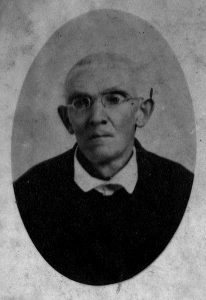I recently reprocessed the Louis Round Wilson Photograph Collection, which contains lots and lots of fascinating portraits from the late 19th-early 20th centuries (tintypes, ambrotypes, cabinet cards, and even a cyanotype). Among these treasures, I found one portrait that — much like the subject’s ears — really stuck out.

On the back of this card-mounted photo is written: “Ghost Elliott, buried near Grifton, NC. A noted NC teacher and presumably an ‘infidel.’ He influenced Uncle Needham Herring of Wilson, Mrs. Cusight’s (?) brother.”
The photographer’s stamp on the front reads (I’m nearly certain) “C. Q. Brown’s Art Studio.” A look at Stephen Massengill’s Photographers in North Carolina reveals a C. O. Brown Art Studio in Mount Olive (in the book’s index, but when you go to the actual page it says “G. O. Brown”). The Mount Olive location seems probable, given its proximity to Grifton . . . so I’m guessing Massengill’s guide is in error on this one and that it should in fact be C. Q. Brown.
My curiosity piqued, I began madly Googling, but could find surprisingly little about this “noted North Carolina teacher” and “infidel.” In James Sprunt’s Chronicles of the Cape Fear River, 1660-1916 (p. 94, under “Public Buildings in Wilmington”), I found the following tidbit:
“The Innes Academy, later known as the Old Academy Building, was a great brick structure, the first floor of which was used as a theatre and the second as a schoolroom. In the latter, Ghost Elliott, a famous teacher in the early days, at one time taught.”
Then, in an e-book titled “Biennial report of the Superintendent of Public Instruction of North Carolina, for the scholastic years … [serial] (Volume 1896/97-1897/98),” under Sampson County, I hit the jackpot.
(The text below is cleaned up to correct OCR errors, but a few bloopers remain. Emphasis added).
“There was a school of some note at a place called the Kornegay House, in the eastern part of the county, not far from the site of Duplin’s old courthouse, about 1830, Dr. Fields being Principal.
It was superseded by Spring Vale Academy, not far from its site, which was a very flourishing institution, to the outbreak of the war, the pupils averaging about 80, sometimes reaching 100, from Sampson, Duplin, Wayne and Bladen. The teachers, successively, were Joseph S. Rhodes, George W. Johnson, Angus C. McNeill, Miss Bizzell, John G. Elliott, Solomon J. Faison.
Of these, John G. Elliott deserves special notice. He was at the University with James K. Polk, and walked fifty miles to the University in 1847 in order to greet him. He was a good classical scholar, eccentric in manner, devoted to his calling as a teacher and extremely charitable in giving tuition; high-principled, but agreeing with no one in religious views. He was a philanthropist-teacher. His personal appearance was peculiar. He was so thin and cadaverous that from his youth he was known as ‘Ghost Elliott,’ and, falling into the humor, he added “G.” (for ghost) to his Christian name. Rev. Dr. C. F. Deems describes him as he appeared in 1855: ‘Small, thin, washed out by multitudinous ablutions, built after the architectural design of an interrogation mark, with a disproportionately large head, the white hair on which was cropped to a length measured exactly the thickness of the comb, he was a man whose appearance attracted attention everywhere. In some departments he was very learned, and his [___] acquirements dominated his eccentricities and won for him the respect of a large class of citizens.’ I add that he was accustomed to ride intellectual hobbies. I remember him at the University Commencement of 1847, when President Polk and a brilliant collection of visitors were on the Plill [?], he would talk of nothing else than Greek adverbs and prepositions.”
So I ask you, readers, why has someone so “famous,” “noted” and influential in his time, and obviously such an unusual character, become somewhat of an historical “ghost”? Is there some cache of knowledge/information about John Ghost Elliott out there that I didn’t find?
-Elizabeth Hull

